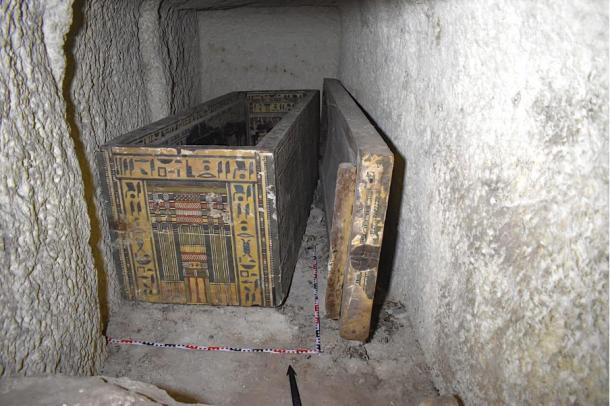
New Burial Chamber Discovered in Largest Non-Royal Tomb From Senusret I’s Reign
A joint Egyptian-German archaeological mission has unearthed the funerary chamber of a woman named "Idi”, the sole daughter of Djefai-Hapy, the governor of Asyut during the reign of Pharaoh Senusret I (1961-1915 BC). Its historical significance lies in the fact that the governor’s tomb is the largest non-royal tomb of the era. The 3,900-year-old burial chamber contained two coffins, one nested inside the other, both imbued with texts that depict the journey to the afterlife.
- 800 Ancient Egyptian Tombs Discovered at Middle Kingdom Necropolis
- Huge 4000-year-old Underground Hidden Tomb of Cult Egyptian King Senwosret III Will Soon Open to the Public

The new burial chamber was found under Djefai-Hapy's tomb, at the Western Mount of Asyut, Egypt. (Egyptian Ministry of Tourism & Antiquities)
Artistically Detailed, Immaculately Preserved
The discovery occurred during cleaning work inside Djefai-Hapy's tomb led by the universities of Sohag and Berlin, as part of a joint Egyptian-German archaeological mission. Dr. Mohamed Ismail Khaled, Secretary-General of the Supreme Council of Antiquities, further explained that Idi’s funerary chamber was discovered in the northern shaft of her father's tomb, at a depth of roughly 15.25 meters (50 feet), according to a press statement on Facebook.
The outer coffin measured 2.62 meters (8.6 feet) in length, while the inner coffin was 2.30 meters (7.5 feet). Dr. Khaled emphasized that the coffins are among the most artistically detailed and well-preserved ever discovered in the region.
- Religion and Magic in Amarna: Battling Forces from Different Realms
- Ramesses II - Original Sarcophagus Identified Within the Valley of Kings

The coffin and its lid are highly decorated. (Egyptian Ministry of Tourism & Antiquities)
In addition to the coffins, the mission also unearthed the lid of the inner coffin, a box housing canopic jars intended to hold the deceased’s internal organs, and several wooden figurines. Although much of the tomb had been plundered and damaged in antiquity, these funerary objects still offer valuable insights into the burial practices and social status of Idi, the daughter of an influential provincial ruler.

Wooden figurines found in the burial chamber. (Egyptian Ministry of Tourism & Antiquities)
“Preliminary studies suggest that Idi died before reaching the age of 40 and suffered from a congenital foot defect,” explained Dr. Ismail.
The investigations have revealed that, in antiquity, looters had not only stolen many of the burial goods but had also desecrated Idi’s remains, removing her body and dismembering it. Despite this, analysis of her skeletal remains suggests that she passed away before the age of 40 and suffered from a congenital deformity in one of her feet, a condition that likely impacted her quality of life, reports LBV Magazine.
The mission plans to continue their work, which includes cleaning and analyzing Idi’s remains further to uncover more details about her health, lifestyle, and the circumstances of her death.

Detail of some of the hieroglyphic writing inside the sarcophagus. (Egyptian Ministry of Tourism & Antiquities)
Pharaoh Senusret I and Jefai-Hapy: 12th Dynasty Rule
Pharaoh Senusret I, also known as Sesostris I, was the second ruler of Egypt's Twelfth Dynasty and one of the most powerful kings of the Middle Kingdom. He reigned from approximately 1961 to 1915 BC and is often credited with consolidating the political, military, and economic structures that characterized this era. Senusret I succeeded his father, Amenemhat I, who had established the Twelfth Dynasty after a period of instability, reports Ahram Online.
Djefai-Hapy, one of the most important governors in his reign, held a key administrative and political role, overseeing one of Egypt's most significant provincial centers. Asyut, located in Middle Egypt, was strategically important due to its location along key trade routes and its proximity to Nubia, a region vital to Egypt for its resources like gold and other minerals.
The tomb of Djefai-Hapi, also known as Tomb 1, is renowned as the largest preserved rock-cut tomb belonging to a private individual from Egypt’s Middle Kingdom. This grand tomb is carved directly into a mountainside in the necropolis of Asyut, reports The Miami Herald. Measuring approximately 400 feet (122 meters) in length and rising over 30 feet (9 meters) high inside, the tomb exemplifies the architectural sophistication and scale reserved for elite figures outside the royal family.
The Minister of Tourism and Antiquities, Sherif Fathy, lauded the efforts of the mission, emphasizing the continued contribution of Egyptian archaeological teams in revealing new dimensions of Egypt's ancient history. He reiterated the Ministry’s commitment to fully supporting these missions to ensure the preservation, protection, and study of Egypt’s cultural heritage.
Top image: Idi's burial chamber with sarcophagus at the tomb of Djefai-Hapy Asyut, Egypt. Source: Egyptian Ministry of Tourism & Antiquities
By Sahir Pandey
References
Carvajal, G. 2024. Archaeologists excavated 50 feet under Egypt’s largest non-royal tomb and found Idi’s double sarcophagus. Available at: https://www.labrujulaverde.com/en/2024/10/archaeologists-excavated-50-feet-under-egypts-largest-non-royal-tomb-and-found-idis-double-sarcophagus/.
Milligan, M. 2024. Archaeologists discover a burial chamber containing two ornate coffins. Available at: https://www.heritagedaily.com/2024/10/archaeologists-discover-a-burial-chamber-containing-two-ornate-coffins/153572#google_vignette.















